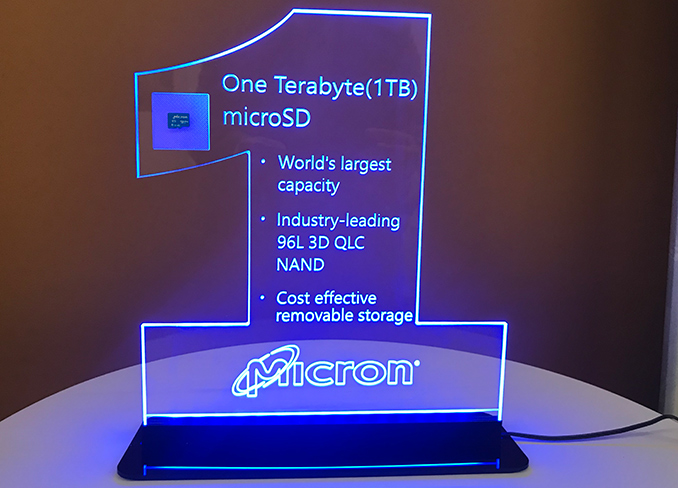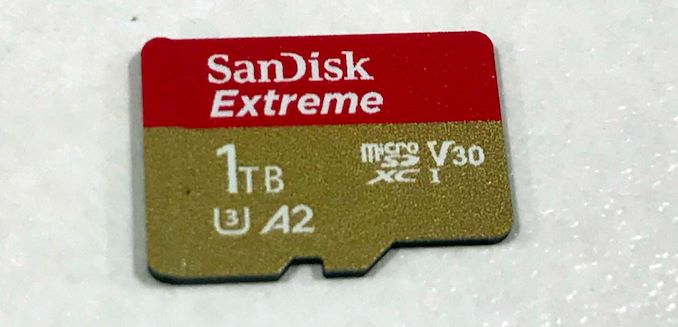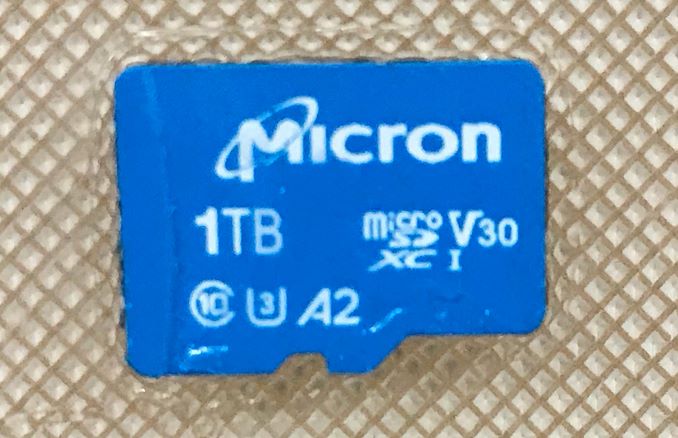Micron and Western Digital Unveil 1 TB microSD Cards with A2
by Anton Shilov on February 26, 2019 12:00 PM EST
The evolution of 3D NAND memory had enabled storage device makers to offer rather unprecedented capacities. To that end, this week at Mobile World Congress, Micron and Western Digital their first 1TB microSDXC cards, marking the point where the pint-sized storage cards have become too big to be measured in mere gigabytes. Besides offering loads of storage space, the cards also feature SD Association’s A2 capabilities and support running Android applications directly from the card.
The c200 1 TB microSDXC card from Micron and the SanDisk Extreme 1 TB microSDXC card from Western Digital are based on 96-layer 3D NAND flash memory from the respective companies as well as controllers designed in-house. Both cards are also compatible with existing SDXC hosts. While Micron confirms that its card uses 3D QLC NAND, Western Digital is somewhat reluctant to disclose the type of memory it uses. It is logical to assume that the SanDisk card also uses the company’s second -generation 3D QLC NAND devices, but this information is not official.
Moving on to performance offered by the products, both cards support the A2 app performance class specification. This means they can provide random performance of at least 4000 read IOPS and 2000 write IOPS, as well as support for such capabilities as command queuing (with a minimum depth queue of 2 and a maximum depth queue of 32) to optimize random read performance, caching to hit write performance targets, as well as self-maintenance capabilities.
Micron says that its c200 1 TB microSD card is capable of up to 100 MB/s sequential read speeds as well as up to 95 MB/s sequential write speeds. The card also supports the V30 video speed class specifications, so this means its minimum write speed is at least 30 MB/s.
Meanwhile for their part, Western Digital says that its card is capable of 160 – 170 MB/s read/write speeds, which makes it the "world’s fastest microSDXC 1 TB UHS-I card." There is a catch though: the UHS-I bus only supports up to 104 MB/s throughput, so SanDisk Extreme 1 TB microSDXC cards can only hit the advertised speeds on hosts supporting DDR-200 transfer rates. While there are some smartphones that can do this, it is usually not advertised. So in the vast majority of cases the card will hit the maximum that the bus offers: around 100 MB/s reads and writes. Meanwhile, the card also carries the V30 badge and its minimum write speed is 30 MB/s.
Western Digital plans to start selling its 1 TB microSDXC card in April at a price of $449.99. As is usually the case for storage products, this is a bit of a price premium for the top capacity model; by comparison, WD's 512 GB microSDXC product costs $199.99.
Meanwhile Micron does not disclose MSRP of its 1 TB microSDXC card, but the company indicates that it will be “competitive for the target audience”. The product will be available sometime in the second quarter.
Related Reading:
- SanDisk Extreme microSD Cards with A2 App Performance Spec Unveiled: 4K/2K IOPS
- HiDisc’s 1 TB SDXC Card with A2 Rating Now at Retail
- ADATA XPG Launches Gaming microSD Cards, up to 512GB
- Lexar Launches 512 GB microSD Card with A2 App Performance Spec
Sources: Micron, Western Digital












18 Comments
View All Comments
brakdoo - Tuesday, February 26, 2019 - link
Funny thing Micron sold the lexar brand to sell consumer microSD cards just one year later under the Micron brand...Sivar - Tuesday, February 26, 2019 - link
That makes for 7800x the capacity of early 128MB microSD cards. 7800x improvement with the same physical media.3.5" Floppy disks, on the other hand, went from 1.44MB to 2.88, but no one used 2.88.
CD-sized disks went from ~650MB (CD) to around 100GB (3-layer ultra HD Blu-ray), just a 153x improvement, and CDs were released in the early 80's!
Death666Angel - Tuesday, February 26, 2019 - link
Neat comparisons!peevee - Tuesday, February 26, 2019 - link
3D does it for you. Imagine a stack of 96 Blue-ray disks. :)Reflex - Tuesday, February 26, 2019 - link
To be fair, 3.5" floppy discs were introduced at 400kb, ended at 2.88MB which is about a 720% capacity increase. Still not stunning but not as bad as a simple doubling.strtj - Tuesday, February 26, 2019 - link
That's a terrible comparison for floppy drives. They started out at 80KB in the early '70s and ended up at the 240MB LS-240 drive, or even higher if you consider ZIP disks a type of floppy.Death666Angel - Tuesday, February 26, 2019 - link
3.5" disks started at 80KB in the early 70's? You should edit Wikipedia and give the right citation. The article starts with "In 1981, Sony introduced their 3 1⁄2-inch floppy disk cartridge (90.0 mm × 94.0 mm) having a single sided unformatted capacity of 218.8 KB and a formatted capacity of 161.2 KB." It also references '76 as the time when 5.25" disks were discussed. If you have other information, I'd like to see that. Or maybe you were talking about plastic diskettes with magnetic discs inside them in general? If that is the case and especially if you want to include ZIP disks, we might as well throw EEPROMs into the mix. Which would trounce everything again. :DIthaqua - Tuesday, February 26, 2019 - link
https://en.wikipedia.org/wiki/List_of_floppy_disk_...Looks like wiki was already correct.
My 1st experience with floppy disks was the DEC 01 at 250KB. God that was so long ago.
Ithaqua - Tuesday, February 26, 2019 - link
Ah, see your point now format size.psychobriggsy - Tuesday, February 26, 2019 - link
Just to think I remember the day in the pub when a nerd pulled out a 256MB full size SD card for their digital camera, and I was amazed at the capacity, and the small size, and how that compared to my first 3.5" HDD about a decade before.